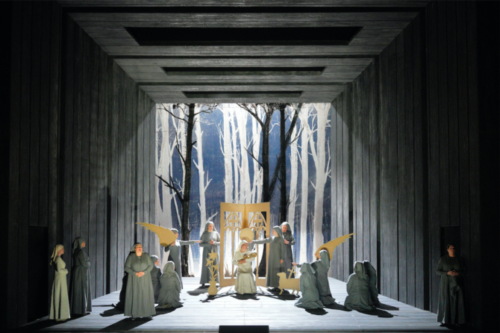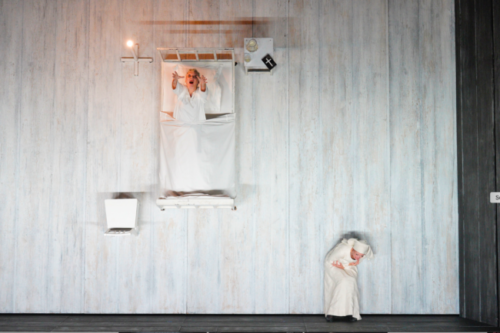 United States Poulenc, Dialogues of the Carmelites: Soloists, orchestra and chorus of San Francisco Opera / Eun Sun Kim (conductor). War Memorial Opera House, San Francisco, 26.10.2020. (HS)
United States Poulenc, Dialogues of the Carmelites: Soloists, orchestra and chorus of San Francisco Opera / Eun Sun Kim (conductor). War Memorial Opera House, San Francisco, 26.10.2020. (HS)

Production:
Production – Olivier Py
Revival director – Daniel Izzo
Production designer – Pierre-André Weitz
Lighting – Bertrand Killy
Chorus director – John Keene
Cast:
Blanche de la Force – Heidi Stober
Madame de Croissy – Michaela Schuster
Madame Lidoine – Michelle Bradley
Mother Marie – Melody Moore
Sister Constance – Deanna Breiwick
Marquis de la Force – Dale Travis
Chevalier de la Force – Ben Bliss
Chaplain – Brenton Ryan
Mother Jeanne – Catherine Cook
Sister Mathilde – Taylor Raven
Jailor / M. Javelinot / Thierry – Efraín Solís
First Commissioner – Christopher Oglesby
Second Commissioner / First Officer – Hadleigh Adams
Nuns – Deborah Nansteel, Alexandra Sanchez, Esther Tonea, Chea Kang, Mikayla Sager, Gabrielle Beteag, Jesslyn Thomas, Anne-Marie MacIntosh, Elisa Sunshine, Buffy Baggott, Courtney Miller
San Francisco Opera made a great choice programming Poulenc’s Dialogues of the Carmelites for this, its centennial season. The opera had been a landmark for the company, making its U.S. premiere here only seven months after it premiered at La Scala. Soprano Leontyne Price (in the role of Madame Lidoine) made her debut with a major opera company, launching a historic career and a long relationship with San Francisco Opera.
It has been forty years since the company’s most recent performance of Dialogues, and the first time it has been sung in the original French. Previous performances were in English, as the composer requested be done in the years before titles.
When seen and heard in the fifth of six performances, superb singing and acting up and down the big cast, plus a stunning performance from the orchestra under music director Eun Sun Kim, added up to nothing short of a triumph. Kim brought out Poulenc’s distinctive musical flavors, shaped perfect balances with the singers and found ideal tempos. The many role debuts fit seamlessly into an ensemble that produced one electric scene after another and some gorgeous a cappella chorus moments.
The production, borrowed from Théâtre des Champs-Elysée and Théâtre Royal de la Monnaie, provided a provocative underpinning for the story of a cloister of nuns forced to confront, and ultimately succumb to, Robespierre’s Reign of Terror in the early 1790s. Olivier Py’s production design (his first foray into the U.S.) had panels open out and up to create a cross and reveal the mother superior’s room or the prison where the nuns were held in the penultimate scene. At times, the panels slid silently from the wings to show a backdrop of winter trees.
Within this plain frame – appropriate for a story set in a modest cloister – were plenty of telling details. Giving a religious context to revolutionary slogans, Madame Lidoine adds ‘EN DIEU’ (in God) in an Act III scene to ‘LIBERTÉ’, which had been scrawled on a blank wall by a servant in the opening scene. At various points during orchestral interludes, charming tableaux used a cross, a sheep, angel wings and a dove carved from lightweight wood as props to depict The Annunciation, The Nativity, The Last Supper and The Crucifixion.
Most strikingly, the long death scene of the original prioress in Act I was played from a bed hanging vertically on a wall, as if seen from above, the light from a window casting ominous shadows around her.
Throughout, revival director Daniel Izzo got juicy acting performances that felt like they were really happening.

Dialogues focuses on the emotional journey of Blanche, a young woman whose wealthy family has managed to stay afloat as revolutionary mobs and the Reign of Terror have had their effect on them. A psychological wreck at the start of the evening, Blanche seems to lose her nerve but ultimately gathers the courage to join her fellow nuns in martyrdom. Heidi Stober, who has put together a string of successes in soprano roles at San Francisco Opera since her 2010 debut as Sophie in Werther, invested Blanche with nervousness and neuroses galore, all the while rendering the music with a gleam.
She was not the only high-level achiever among the cast. Making their company debuts, Michaela Schuster delivered a stunning death scene as the prioress, Madame de Croissy, who can’t summon the words to help Blanche find her way; and Deanna Breiwick managed to turn the bubbly Sister Constance into a flesh-and-blood character, all the while making her light soprano dance.
Michelle Bradley, who is singing Aida at the Metropolitan Opera this season, had been preparing for her company debut in a 2020 Ernani, canceled by the pandemic. She brought a sense of majesty and dignity to Madame Lidoine, the next prioress. It was surely no coincidence that Bradley brought these similar traits, and an impressively assured sound, to the role that Leontyne Price, another African-American soprano, sang here in 1957 and 1982.
On the male side, the standout was Ben Bliss, who brought a brilliantly focused tenor to bear as Blanche’s older brother and parried aptly with Stober in their testy scenes. Brenton Ryan seems to be emerging as a worthy ‘house tenor’, his natural style of singing and acting bringing the Chaplain to life; he did well in Antony and Cleopatra and Eugene Onegin earlier this season.
There were no weak links in the rest of the cast. The chorus of 16 nuns found ways to portray individuals in dramatic scenes and sang with beauty in the hymns in Act III. They were especially fine in the always-effective final scene, where their voices drop out one by one as they sing ‘Salve regina’ until none are left.
In that last scene, rather than the nuns exiting the stage to perish as we hear the guillotine slash, Py and Izzo lined them up across the stage like a chorus. They responded to the fall of the guillotine one at a time, then walked off stage toward a starry sky. Each held out her arms, alluding to the crucifixion, but the effect struck me as if, one by one, they had flown off almost peacefully.
Harvey Steiman
